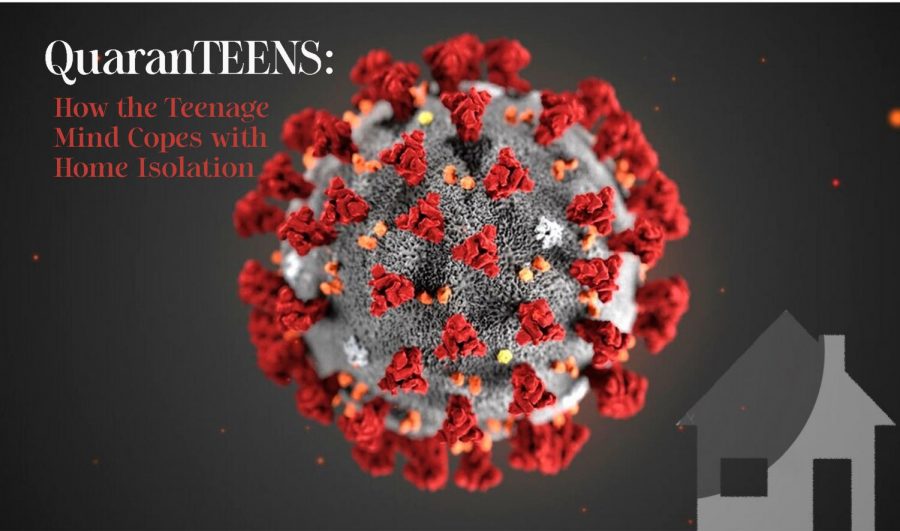media by Kira Zizzo
The rapid spread of the Coronavirus has lead to the government urging social distancing. Students are adapting to this change, finding new ways to occupy and express themselves. photo (before edits): CDC
QuaranTEENS: How the Teenage Mind Copes with Home Isolation
Social distancing is highly encouraged due to the spread of Coronavirus. This quarantine causes drastic social changes in teenage life, marking a turning point in how students spend their free time.
As the Coronavirus spreads, so do concerns involving public health and safety, which have encouraged social distancing. Time spent social distancing will increase due to Governor Jared Polis’s announcement that all in person instruction will be suspended through April 17. In a lifestyle where students routinely socially interact with their peers at school, this social normalcy begins to erode, leaving students to occupy the time isolated within their homes.
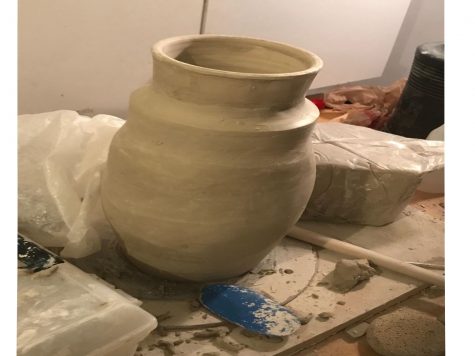
Ale Basile ’22 works on a pottery piece in her garage during the Coronavirus quarantine. Photo courtesy: Ale Basile.
Ale Basile ‘22 passes time at home by creating pottery. She spends at least two hours each day in her garage throwing pottery on her wheel and fine-tuning pieces. Due to the lack of resources available in light of the Coronavirus, Basile works to conserve clay and slows down her creative process to save materials. Basile implements the sgraffito method, where she underglazes pieces to add detail.
“I’ve been working on combining multiple pieces into one big pot, working an average of three to four days on each project,” Basile said.
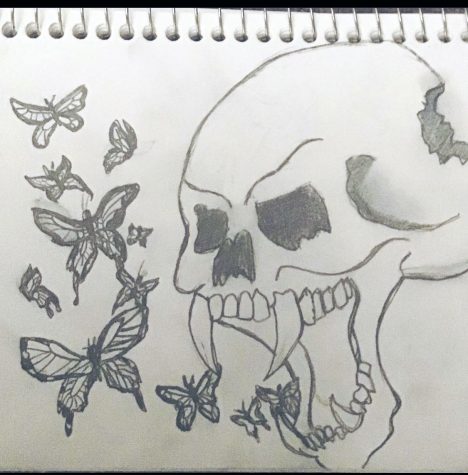
This illustration by Claire Price ’22 is an artistic way she expressed her feelings about the Coronavirus Pandemic. Photo courtesy: Claire Price.
Claire Price ‘22 also uses an artistic approach to curb boredom. She illustrated a skull that expresses her perspective on the current state of the Coronavirus and society. The butterflies represent the silver lining and hope, while fangs are symbolic of media hysteria. Price’s art depicts a hole in the skull that is a consequence of anxiety. She used a pencil and paper to conceptualize the world around her and its effects on her. Price not only uses art to process this pandemic, but she also wants to help others understand this moment in history.
“I’ve been doing a lot of thinking and I realized that we are the source. 50 years from now, when our kids are studying the Covid-19 pandemic of 2020, they’ll be looking to us for information,” Price said.
Price and her friends started a Google document titled “The Diary of Corona”, where they write their opinions, thoughts, and concerns in conjunction with a recollection of the events that have transpired during the Coronavirus. This information is directed towards an audience in the future, to be used as a primary source.
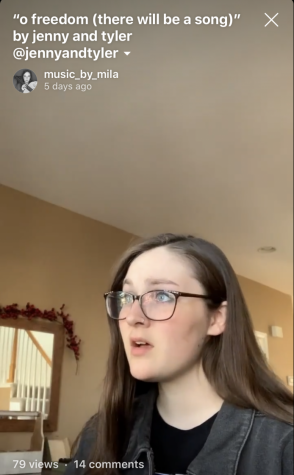
Mila Cox ‘22 posted a video of herself singing on her music Instagram Account during a period of social distancing. Photo courtesy: Mila Cox.
Instead of physical manifestations of expression, Mila Cox ‘22 verbally demonstrates herself through song. She sings, plays piano, and strums on the guitar to find the notes that provide guidance through this time of uncertainty and social isolation. Cox played “O Freedom (There Will be a Song)” by Jenny and Tyler on her music Instagram account @music_by_mila. This song signifies breaking free from others and becoming familiar with oneself.
“Especially since I can’t go out and do a lot right now, it really encourages me to be able to fill my own space with music, particularly music that I haven’t learned yet; it lets me push myself even without a lot of social resources,” Cox said.
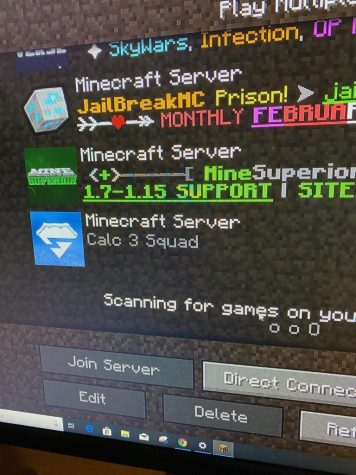
Aditya Vepa ‘20 and his Calculus Three class visualize multivariable calculus through interaction on a Minecraft server. Photo courtesy: Aditya Vepa.
Calculus Three students are able to congregate safely online through a shared Minecraft server. This server applies math concepts to building and coding in an online world. Students visualize integrals on an interactive map while constructing three-dimensional elements. They work with the notion of three-dimensional Riemann sums to assemble complex buildings, cities, and functional systems.
“It’s a good way to wrap our heads around multivariable calculus while also having a lot of fun. No other class we know twists Minecraft into an educational activity,” Aditya Vepa ‘20 said.
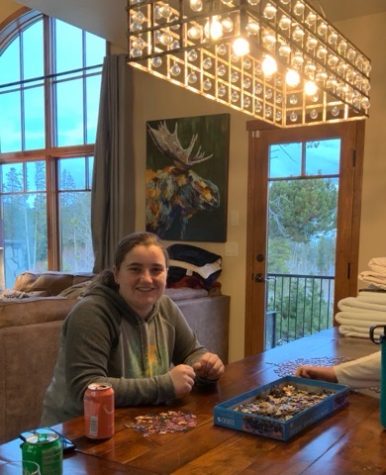
Ainsley Messenger ‘20 and her brother, Camden Messenger ‘22 assemble a puzzle together. Photo courtesy: Colleen Messenger.
Other students find themselves bonding with siblings due to school cancellations and workplace precautions. Siblings Ainsley Messenger ‘20 and Camden Messenger ‘22 assemble a puzzle together at home. Their older brother returned home from college due to campus cancellations. With limited options, siblings engage in teamwork to achieve small victories.
“I haven’t been able to participate in any of my favorite activities, so I am trying to enjoy some time at home doing things besides watching TV and being bummed about the situation,” Ainsley said.

Kyra Peck ‘22 and Savannah Avery ‘22 climb the Castle Rock, distancing themselves from others who may have Coronavirus. Photo courtesy: Kyra Peck.
Social distancing for students such as Kyra Peck ‘22 and Savannah Avery ‘22 includes spending time with one other person outside of the home. Peck and Avery hiked near their homes, climbing the Castle Rock on March 18.
“There are two ways to look at it. One is staying in your house, away from people and that can help stop the spread of the virus. [The other is] if you are with people a few feet away, it’s not going to change much since you are already with them,” Peck said.
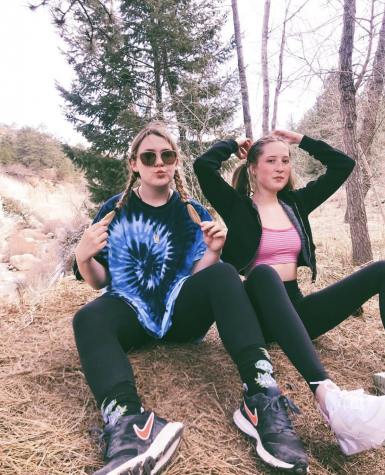
Catie Vick ‘22 and Mackenzie Alice ‘20 hike at Castlewood Canyon National Park to escape from the indoors and the chance of contracting the Coronavirus. Photo courtesy: Catie Vick.
For other students, a hike further away from home distances themselves from others. Catie Vick ‘22 and Mackenzie Alice ‘20 walked the trail at Castlewood Canyon National Park. Vick and Alice were secluded from other possible human contact while they spent time outside.
“Social distancing is very important and since we can’t do stuff like concerts or go to museums, it’s fun to get into nature with friends that way,” Vick said.
Social distancing will continue to impact student interaction and redefine what it means to have a social life. When familiar aspects of life disappear, new practices begin to emerge that students use to make sense of the Coronavirus pandemic sweeping the world.

